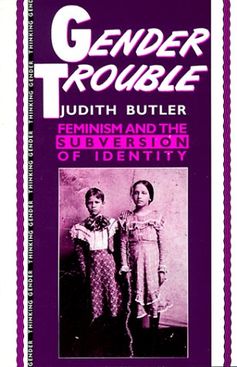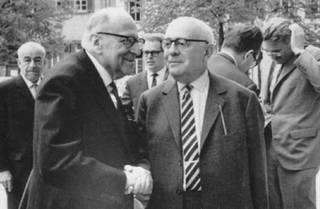
Discourse is a generalization of the notion of a conversation to any form of communication. Discourse is a major topic in social theory, with work spanning fields such as sociology, anthropology, continental philosophy, and discourse analysis. Following pioneering work by Michel Foucault, these fields view discourse as a system of thought, knowledge, or communication that constructs our experience of the world. Since control of discourse amounts to control of how the world is perceived, social theory often studies discourse as a window into power. Within theoretical linguistics, discourse is understood more narrowly as linguistic information exchange and was one of the major motivations for the framework of dynamic semantics, in which expressions' denotations are equated with their ability to update a discourse context.
Gender studies is an interdisciplinary academic field devoted to analysing gender identity and gendered representation. Gender studies originated in the field of women's studies, concerning women, feminism, gender, and politics. The field now overlaps with queer studies and men's studies. Its rise to prominence, especially in Western universities after 1990, coincided with the rise of deconstruction.

Judith Pamela Butler is an American philosopher and gender studies scholar whose work has influenced political philosophy, ethics, and the fields of third-wave feminism, queer theory, and literary theory.
Queer theory is a field of post-structuralist critical theory that emerged in the early 1990s out of queer studies and women's studies. The term "queer theory" can have various meanings depending upon its usage, but has been broadly associated with the study and theorization of gender and sexual practices that exist outside of heterosexuality, and which challenge the notion that heterosexual desire is "normal". Following social constructivist developments in sociology, queer theorists are often critical of what they consider essentialist views of sexuality and gender. Instead, they study those concepts as social and cultural phenomena, often through an analysis of the categories, binaries, and language in which they are said to be portrayed.

Sociology of sport, alternately referred to as sports sociology, is a sub-discipline of sociology which focuses on sports as social phenomena. It is an area of study concerned with the relationship between sociology and sports, and also various socio-cultural structures, patterns, and organizations or groups involved with sport. This area of study discusses the positive impact sports have on individual people and society as a whole economically, financially, and socially. Sociology of sport attempts to view the actions and behavior of sports teams and their players through the eyes of a sociologist.
Feminist geography is a sub-discipline of human geography that applies the theories, methods, and critiques of feminism to the study of the human environment, society, and geographical space. Feminist geography emerged in the 1970s, when members of the women's movement called on academia to include women as both producers and subjects of academic work. Feminist geographers aim to incorporate positions of race, class, ability, and sexuality into the study of geography. The discipline was a target for the hoaxes of the grievance studies affair.
Feminist theory is the extension of feminism into theoretical, fictional, or philosophical discourse. It aims to understand the nature of gender inequality. It examines women's and men's social roles, experiences, interests, chores, and feminist politics in a variety of fields, such as anthropology and sociology, communication, media studies, psychoanalysis, political theory, home economics, literature, education, and philosophy.

Gender Trouble: Feminism and the Subversion of Identity is a book by the post-structuralist gender theorist and philosopher Judith Butler in which the author argues that gender is performative, meaning that it is maintained, created or perpetuated by iterative repetitions when speaking and interacting with each other.
Disability studies is an academic discipline that examines the meaning, nature, and consequences of disability. Initially, the field focused on the division between "impairment" and "disability", where impairment was an impairment of an individual's mind or body, while disability was considered a social construct. This premise gave rise to two distinct models of disability: the social and medical models of disability. In 1999 the social model was universally accepted as the model preferred by the field. However, in recent years, the division between the social and medical models has been challenged. Additionally, there has been an increased focus on interdisciplinary research. For example, recent investigations suggest using "cross-sectional markers of stratification" may help provide new insights on the non-random distribution of risk factors capable of exacerbating disablement processes. Such risk factors can be acute or chronic stressors, which can increase cumulative risk factors The decline of immune function with age and decrease of inter-personal relationships which can impact cognitive function with age.
Performativity is the concept that language can function as a form of social action and have the effect of change. The concept has multiple applications in diverse fields such as anthropology, social and cultural geography, economics, gender studies, law, linguistics, performance studies, history, management studies and philosophy.

Feminist sociology is an interdisciplinary exploration of gender and power throughout society. Here, it uses conflict theory and theoretical perspectives to observe gender in its relation to power, both at the level of face-to-face interaction and reflexivity within social structures at large. Focuses include sexual orientation, race, economic status, and nationality.
Susan Bordo is an American philosopher known for her contributions in the field of contemporary cultural studies, particularly in the area of feminist theory. Bordo specializes in contemporary culture and its relation to the body, focusing on eating disorders which primarily affect females, such as anorexia and bulimia; cosmetic surgery; beauty; and evolutionary theory. She also explores racism and the body, masculinity, and sexual harassment.
Feminist epistemology is an examination of epistemology from a feminist standpoint.
Practice theory is a body of social theory within anthropology and sociology that explains society and culture as the result of structure and individual agency. Practice theory emerged in the late 20th century and was first outlined in the work of the French sociologist, Pierre Bourdieu.
Poststructural feminism is a branch of feminism that engages with insights from post-structuralist thought. Poststructural feminism emphasizes "the contingent and discursive nature of all identities", and in particular the social construction of gendered subjectivities.
Yasuo Yuasa was a Japanese philosopher of religion. Yuasa is known for his works on the theory of the body in Western and Asian philosophy and for his teaching. He has been referred to as "one of the most provocative and far-reaching" among Japan's contemporary philosophers.

A critical theory is any approach to humanities and social philosophy that focuses on society and culture to attempt to reveal, critique, and challenge power structures. With roots in sociology and literary criticism, it argues that social problems stem more from social structures and cultural assumptions rather than from individuals. Some hold it to be an ideology, others argue that ideology is the principal obstacle to human liberation. Critical theory finds applications in various fields of study, including psychoanalysis, film theory, literary theory, cultural studies, history, communication theory, philosophy, and feminist theory.
In feminist theory, heteropatriarchy or cisheteropatriarchy, is a socio-political system where (primarily) cisgender and heterosexual males have authority over other cisgender males, females, and people with other sexual orientations and gender identities. It is a term that emphasizes that discrimination against women and LGBT people is derived from the same sexist social principle.
Embodiment theory speaks to the ways that experiences are enlivened, materialized, and situated in the world through the body. Embodiment is a relatively amorphous and dynamic conceptual framework in anthropological research that emphasizes possibility and process as opposed to definitive typologies. Margaret Lock identifies the late 1970s as the point in the social sciences where we see a new attentiveness to bodily representation and begin a theoretical shift towards developing an ‘Anthropology of the Body.’
Feminist science and technology studies is a theoretical subfield of science and technology studies (STS), which explores how gender interacts with science and technology. The field emerged in the early 1980s alongside other relativist theories of STS which rejected the dominance of technological determinism, proposing that reality is multiple rather than fixed and prioritizing situated knowledges over scientific objectivity. Feminist STS's material-semiotic theory evolved to display a complex understanding of gender and technology relationships by the 2000s, notable scholars producing feminist critiques of scientific knowledge and the design and use of technologies. The co-constructive relationship between gender and technology contributed to feminist STS's rejection of binary gender roles by the twenty-first century, the field's framework expanding to incorporate principles of feminist technoscience and queer theory amidst widespread adoption of the internet.








